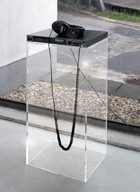Florian Hecker
07 Jul - 25 Aug 2007
FLORIAN HECKER
Opening 07.07.07, 19 – 21h
Exhibition 07.07.07 – 25.08.2007
Dark Energy (22'18")
4 Channel Electro Acoustic Sound (MLP LosslessTM encoded, 24Bit 44,1KHz),
DVD-A Player, Loupspeaker System
2007
I want to bring the stars down and move them around. Don't you have this kind of dream? Iannis Xenakisi Imagine a new form of energy, or perhaps a new constant of Nature, filling the whole Universe and yet so mysterious that it cannot be studied in any laboratory experiment. Imagine it having the most puzzling properties, such as a negative pressure which is accelerating the expansion of the Universe. Imagine something so strange that Einstein himself, who first saw the possibility of its existence, later reportedly called it “my greatest blunder”. This is one of the greatest unanswered questions of contemporary physics: the nature of dark energy. Roberto Trotta"ii
The scientific development of acoustical quantum theory in the domain of audible sounds was left to the physicist Dennis Gabor (1946, 1947, 1952). Gabor proposed that all sound could be decomposed into a family of functions obtained by time and frequency shifts of a single Gaussian particle. Gabor's pioneering ideas have deeply affected signal processing and sound synthesis. Curtis Roadsiii
Dark Energy is a 4 Channel Soundpiece with a multi channel loudspeaker system. Installed in the gallery space, the piece sculpts an immaterial space, superimposed onto the existing architecture to create a synaesthetic environment in which body, architecture and space intersect.
Dark Energy begins by accumulating a superabundance of sound particles to formulate 30 sequences of sonic entities distributed over the 4 channels. This density expands in amplitude and frequency and unfolds as a rapid succession of oppositions: both stable and unstable, pitch juxtaposed with noise, the synthetic acceleration versus “the Recorded” deceleration – increasingly drifting towards psychoacoustic models of aural perception, escaping boolean logic. At some point the piece is disrupted by a staccato of pulsars before it levitates into an ultrasonic finale of ‘acoustic oscillations’ that leave an afterglow in the space like the ripples of frozen sound-waves.
Sonic entities and points of departure: “Acoustic Oscillations”, Noise, Sound-Color-Filtering, the Neutral, the Recorded, the Ulrasonic, Afterglow. In addition to numerous live performances at venues around the world, Florain Hecker’s work has been presented in exhibitions at Secession, Vienna, TN Probe Gallery, Tokyo, Schindler House, Los Angeles, MUMOK, Vienna and Badischer Kunstverein, Karlsruhe amongst other spaces. Most recently, Florian Hecker has presented a large-scale, computerized Soundpiece at Musée d’Art Moderne de la Ville in Paris and in the Lenbachhaus in Munich.
Galerie Neu is also pleased to announce the release of a new publication Neu 12“ & Neu CD with Florian Hecker this fall with a cover design and concept from Peter Saville.
For more information, please contact the gallery directly via email:mail@galerieneu.com
References:
i Nouritza Matossian Iannis Xenakis 1981
ii Roberto Trotta Clever ways of observing invisible stuff (http://www.scitizen.com, 2006)
iii Curtis Roads Microsound (Cambridge, MIT Press, 2001), p. 54
Opening 07.07.07, 19 – 21h
Exhibition 07.07.07 – 25.08.2007
Dark Energy (22'18")
4 Channel Electro Acoustic Sound (MLP LosslessTM encoded, 24Bit 44,1KHz),
DVD-A Player, Loupspeaker System
2007
I want to bring the stars down and move them around. Don't you have this kind of dream? Iannis Xenakisi Imagine a new form of energy, or perhaps a new constant of Nature, filling the whole Universe and yet so mysterious that it cannot be studied in any laboratory experiment. Imagine it having the most puzzling properties, such as a negative pressure which is accelerating the expansion of the Universe. Imagine something so strange that Einstein himself, who first saw the possibility of its existence, later reportedly called it “my greatest blunder”. This is one of the greatest unanswered questions of contemporary physics: the nature of dark energy. Roberto Trotta"ii
The scientific development of acoustical quantum theory in the domain of audible sounds was left to the physicist Dennis Gabor (1946, 1947, 1952). Gabor proposed that all sound could be decomposed into a family of functions obtained by time and frequency shifts of a single Gaussian particle. Gabor's pioneering ideas have deeply affected signal processing and sound synthesis. Curtis Roadsiii
Dark Energy is a 4 Channel Soundpiece with a multi channel loudspeaker system. Installed in the gallery space, the piece sculpts an immaterial space, superimposed onto the existing architecture to create a synaesthetic environment in which body, architecture and space intersect.
Dark Energy begins by accumulating a superabundance of sound particles to formulate 30 sequences of sonic entities distributed over the 4 channels. This density expands in amplitude and frequency and unfolds as a rapid succession of oppositions: both stable and unstable, pitch juxtaposed with noise, the synthetic acceleration versus “the Recorded” deceleration – increasingly drifting towards psychoacoustic models of aural perception, escaping boolean logic. At some point the piece is disrupted by a staccato of pulsars before it levitates into an ultrasonic finale of ‘acoustic oscillations’ that leave an afterglow in the space like the ripples of frozen sound-waves.
Sonic entities and points of departure: “Acoustic Oscillations”, Noise, Sound-Color-Filtering, the Neutral, the Recorded, the Ulrasonic, Afterglow. In addition to numerous live performances at venues around the world, Florain Hecker’s work has been presented in exhibitions at Secession, Vienna, TN Probe Gallery, Tokyo, Schindler House, Los Angeles, MUMOK, Vienna and Badischer Kunstverein, Karlsruhe amongst other spaces. Most recently, Florian Hecker has presented a large-scale, computerized Soundpiece at Musée d’Art Moderne de la Ville in Paris and in the Lenbachhaus in Munich.
Galerie Neu is also pleased to announce the release of a new publication Neu 12“ & Neu CD with Florian Hecker this fall with a cover design and concept from Peter Saville.
For more information, please contact the gallery directly via email:mail@galerieneu.com
References:
i Nouritza Matossian Iannis Xenakis 1981
ii Roberto Trotta Clever ways of observing invisible stuff (http://www.scitizen.com, 2006)
iii Curtis Roads Microsound (Cambridge, MIT Press, 2001), p. 54

